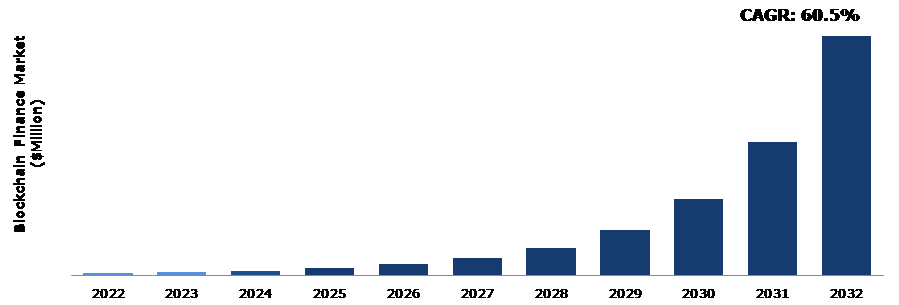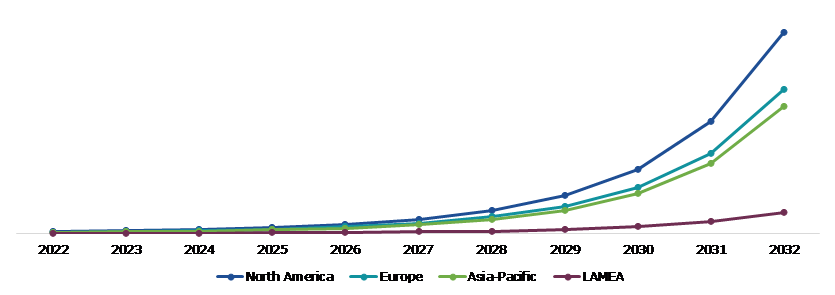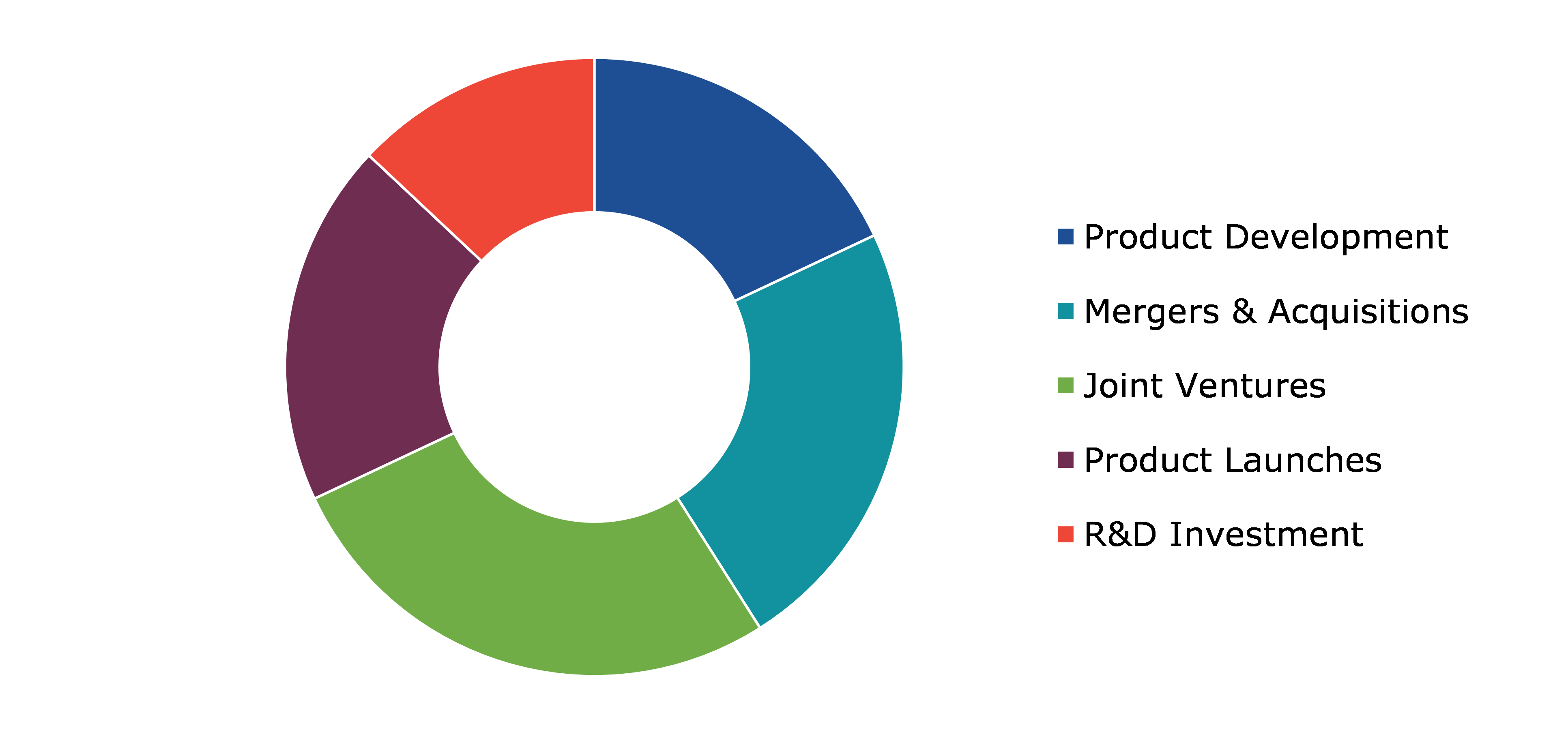Blockchain Finance Market Report
RA09176
Blockchain Finance Market by Type (Public Blockchain, Private Blockchain, and Others), Application (Cross-border Payments & Settlement, Trade Finance, Asset Management, Identity Verification, and Others), and Region (North America, Europe, Asia-Pacific, and LAMEA): Global Opportunity Analysis and Industry Forecast, 2023-2032
Blockchain Finance Overview
Blockchain finance refers to the innovative integration of blockchain technology within the banking and financial sectors to offer more transparent, secure, and efficient business networks and processes. It utilizes the unique attributes of blockchain, such as decentralization and immutability, to reshape traditional financial systems, enabling the issuance of digital securities with enhanced speed, reduced costs, and increased customization. By leveraging digital financial instruments encompassing digital assets, smart contracts, and programmable money, blockchain finance not only optimizes existing operations but also creates an interconnected and programmable network where value is seamlessly exchanged, transforming the landscape of commercial and financial markets. This convergence of blockchain and finance introduces a new paradigm, revolutionizing how transactions, investments, and financial interactions occur, while promoting inclusivity and innovation within the industry.
Global Blockchain Finance Market Analysis
The global blockchain finance market size was $792.3 million in 2022 and is predicted to grow with a CAGR of 60.5%, by generating a revenue of $79,291.40 million by 2032.
Source: Research Dive Analysis
COVID-19 Impact on Global Blockchain Finance Market
The COVID-19 pandemic had a profound impact on the global blockchain finance market. The widespread closure of production facilities disrupted not only the economy but also investments in digital technology. Among the technologies affected, digital ledger technology, or blockchain, experienced significant changes. Major players in the blockchain market responded to the challenges posed by the pandemic by making substantial investments and restructuring their digital strategies. These initiatives are expected to lead to a surge in demand for digital ledger technology in the post-pandemic period. Furthermore, the pandemic accelerated the adoption of digital technologies across various sectors, ranging from government to retail. In response to the crisis, virtually every sector embraced digitalization to sustain their business operations during the pandemic. However, this increased adoption of cloud computing and the Internet of Things (IoT) also brought about increased concerns regarding security and privacy across all industry verticals. Blockchain technology helped to address this condition. It offers solutions such as identity protection, transparency in supply chain operations, and safeguarding health records. Therefore, the growing adoption of digital technologies is predicted to expand the blockchain technology market share, making it an integral component of the evolving global financial landscape in the post-COVID-19 world.
Smart Contracts in Blockchain to Drive the Market Growth
The capacity of blockchain to effectively create trust through smart contracts is possibly its most significant application in finance. Smart contracts are like physical contracts except that the contract's terms are performed in real-time through the blockchain. Smart contracts are beneficial, particularly in the financial sector, for a variety of reasons. These contracts are executed immediately when all criteria are met, do not require any middlemen, and provide increased security. Smart contracts are useful to parties seeking very specific outcomes, such as when a contract is completed by both parties adhering to all set conditions and dissolves in the event of a violation. When an individual invests in a business, the terms and conditions are explicitly defined between the two parties. The unambiguous nature of the contract is beneficial because the blockchain can then enforce those rules by using its network of computers to ensure that all contractual agreements have been met, i.e., that the investor has enough money and has invested in the appropriate number of shares, before the investment proceeds. Because of its efficiency and privacy, smart contract technology is currently at the top of practically everyone's priority list. OpenZeppelin, a leading financial services company in the U.S., creates and manages blockchain-based infrastructure for smart contract platforms. To provide a seamless experience for clients, the firm combines simple coding with tight contract security measures.
Lack of Expertise Knowledge to Restrain the Market Revenue Growth
Implementing and managing a blockchain project is challenging. To complete the process, the business must have extensive knowledge. There is a scarcity of people with experience in specific fields such as encryption and distributed systems because of the huge talent demand and supply imbalance. The blockchain finance market is facing a shortage of engineering and information technology talents, which is not meeting the demand in the industry. The innovation of the technology, as well as its distinctiveness, is the main reason for the shortage of blockchain talent with a specialty. Due to a scarcity of blockchain talent with finance experience, the gap is much larger in finance and accounting. This gap in supply and demand affects R&D activities, which further results in a lack of innovation in the technology and poor management of the existing technology, which affects market growth. These are the major factors anticipated to hamper the market revenue growth in the upcoming years.
Use of Blockchain Technology in Trade Finance to Create Excellent Opportunities
The financial sector anticipates that blockchain can make major advances in trade finance, in particular, in the upcoming years. Distributed ledger technology has considerable advantages in terms of speed, transparency, and capital release. We Trade, a blockchain-based platform established in 2017 by nine banks (Deutsche Bank, HSBC, KBC, Natixis, Nordea, and others) to facilitate cross-border trading, is one significant use case in which bank associations have developed skills in this field. Batavia, a similar platform, was created from a proof of concept begun by UBS and IBM in 2016 and has since included the Bank of Montreal, CaixaBank, and Commerzbank as partners. Both We Trade and Batavia were created on the Hyperledger Fabric platform, and their trade finance blockchain platforms combined in 2018. Similar trade finance blockchain platform mergers are expected to happen in the future to give beneficiaries a better experience. There are challenges related to scale particularly when it comes to 'smaller third parties' being put off by the possibility of centralized, scaled international trade. Therefore, while trade finance is not as close to a potential use as cross-border payments, banks are working intensively on it, which is anticipated to create several growth opportunities in the future. All these factors are anticipated to boost the blockchain finance market expansion during the forecast period.
Global Blockchain Finance Market Share, by Type, 2022
Source: Research Dive Analysis
The public blockchain sub-segment accounted for the highest market share in 2022. In public blockchain, anyone is free to join and participate in the blockchain network's essential functions. Anyone can read, publish, and audit the ongoing operations on a public blockchain network. This characteristic contributes to the self-governed, decentralized nature of public blockchains, which is a key factor frequently promoted for the use of public blockchains in financial services.. A public network uses an incentive mechanism to encourage new players and maintain the network dynamically. Public blockchains are an especially excellent alternative for a genuinely decentralized, democratized, and authority-free operation. Public blockchains are extremely significant because they serve as the foundation for almost any decentralized solution. Furthermore, the large number of network members joining a secure public blockchain protects it against data breaches, hacker attempts, and other cybersecurity threats.
Global Blockchain Finance Market Share, by Application, 2022
Source: Research Dive Analysis
The cross-border payments & settlement sub-segment accounted for the highest market share in 2022. Blockchain cross-border payments are money transfer transactions between parties from different countries that are settled using blockchain technology. When utilized for cross-border payments, blockchain enables payment processing in seconds rather than days, reduces transaction processing costs by 40-80%, and ensures top-tier security and end-to-end traceability of payment-related data. They provide a number of advantages that solve the long-standing issues of high costs, long processing times, and significant operational difficulties associated with traditional cross-border transactions. Furthermore, these technologies ensure the optimal integration of policy, regulatory compliance, and privacy procedures for providing superior end user experiences. Financial institutions and enterprises can improve the efficiency, transparency, and security of cross-border payment operations by leveraging blockchain and cryptocurrencies.
Global Blockchain Finance Market Size & Forecast, by Region, 2022-2032 ($Million)
Source: Research Dive Analysis
The North America blockchain finance market generated the highest revenue in 2022. North America holds the highest share of the market due to the huge number of startups in the region and the growing demand for blockchain networks by large organizations operating in the region. This region's abundance of cutting-edge technological solutions has considerably benefitted the blockchain technology sector. The region's enterprises' rising adoption of blockchain technology is boosting the regional market expansion. Government, retail, and BFSI industries are deploying payment and wallet solutions, smart contracts, and digital identity detection solutions, necessitating the use of blockchain technologies. Furthermore, the increase in use of cryptocurrencies among North Americans is one of the primary factors driving the North America blockchain finance market growth.
Competitive Scenario in the Global Blockchain Finance Market
Investment and agreement are common strategies followed by major market players. For instance, in January 2023, TaxBit, the leading tax and accounting provider for the digital asset economy, announced the acquisition of Tactic, a digital asset financial accounting platform with a streamlined accounting subledger that saves businesses’ hundreds of hours on critical digital asset management and reporting.
Source: Research Dive Analysis
Some of the leading blockchain finance market players are Deloitte Touche Tohmatsu Limited, R3, Alphabet, Circle Internet Financial Limited, JP Morgan Chase, Microsoft Corporation, Goldman Sachs, Global Arena Holding Inc. (GAHI), International Business Machines (IBM) Corporation, Accenture.
| Aspect | Particulars |
| Historical Market Estimations | 2020-2021 |
| Base Year for Market Estimation | 2022 |
| Forecast Timeline for Market Projection | 2023-2032 |
| Geographical Scope | North America, Europe, Asia-Pacific, and LAMEA |
| Segmentation by Type |
|
| Segmentation by Application |
|
| Key Companies Profiled |
|
Q1. What is the size of the global blockchain finance market?
A. The size of the global blockchain finance market was over $792.30 million in 2022 and is projected to reach $79,291.40 million by 2032.
Q2. Which are the major companies in the blockchain finance market?
A. Global Arena Holding Inc. (GAHI), International Business Machines (IBM) Corporation, and Accenture are some of the key players in the global blockchain finance market.
Q3. Which region, among others, possesses greater investment opportunities in the future?
A. Asia-Pacific possesses great investment opportunities for investors in the future.
Q4. What will be the growth rate of the Asia-Pacific Blockchain Finance market?
A. The Asia-Pacific blockchain finance market is anticipated to grow at 62.0% CAGR during the forecast period.
Q5. What are the strategies opted by the leading players in this market?
A. Agreement and investment are the two key strategies opted by the operating companies in this market.
Q6. Which companies are investing more on R&D practices?
A. Deloitte, R3, and Circle Internet Financial Limited are the companies investing more on R&D activities for developing new products and technologies.
1. Research Methodology
1.1. Desk Research
1.2. Real time insights and validation
1.3. Forecast model
1.4. Assumptions and forecast parameters
1.5. Market size estimation
1.5.1. Top-down approach
1.5.2. Bottom-up approach
2. Report Scope
2.1. Market definition
2.2. Key objectives of the study
2.3. Report overview
2.4. Market segmentation
2.5. Overview of the impact of COVID-19 on global blockchain finance market
3. Executive Summary
4. Market Overview
4.1. Introduction
4.2. Growth impact forces
4.2.1. Drivers
4.2.2. Restraints
4.2.3. Opportunities
4.3. Market value chain analysis
4.3.1. List of raw material suppliers
4.3.2. List of manufacturers
4.3.3. List of distributors
4.4. Innovation & sustainability matrices
4.4.1. Technology matrix
4.4.2. Regulatory matrix
4.5. Porter’s five forces analysis
4.5.1. Bargaining power of suppliers
4.5.2. Bargaining power of consumers
4.5.3. Threat of substitutes
4.5.4. Threat of new entrants
4.5.5. Competitive Rivalry intensity
4.6. PESTLE analysis
4.6.1. Political
4.6.2. Economical
4.6.3. Social
4.6.4. Technological
4.6.5. Environmental
4.7. Impact of COVID-19 on the blockchain finance market
4.7.1. Pre-covid market scenario
4.7.2. Post-covid market scenario
5. Blockchain Finance Market Analysis, by Type
5.1. Overview
5.2. Public Blockchain
5.2.1. Definition, key trends, growth factors, and opportunities
5.2.2. Market size analysis, by region, 2023-2032
5.2.3. Market share analysis, by country, 2023-2032
5.3. Private Blockchain
5.3.1. Definition, key trends, growth factors, and opportunities
5.3.2. Market size analysis, by region, 2023-2032
5.3.3. Market share analysis, by country, 2023-2032
5.4. Others
5.4.1. Definition, key trends, growth factors, and opportunities
5.4.2. Market size analysis, by region, 2023-2032
5.4.3. Market share analysis, by country, 2023-2032
5.5. Research Dive Exclusive Insights
5.5.1. Market attractiveness
5.5.2. Competition heatmap
6. Blockchain Finance Market Analysis, by Application
6.1. Cross-border Payments & Settlement
6.1.1. Definition, key trends, growth factors, and opportunities
6.1.2. Market size analysis, by region, 2023-2032
6.1.3. Market share analysis, by country, 2023-2032
6.2. Trade Finance
6.2.1. Definition, key trends, growth factors, and opportunities
6.2.2. Market size analysis, by region, 2023-2032
6.2.3. Market share analysis, by country, 2023-2032
6.3. Asset Management
6.3.1. Definition, key trends, growth factors, and opportunities
6.3.2. Market size analysis, by region, 2023-2032
6.3.3. Market share analysis, by country, 2023-2032
6.4. Identity Verification
6.4.1. Definition, key trends, growth factors, and opportunities
6.4.2. Market size analysis, by region, 2023-2032
6.4.3. Market share analysis, by country, 2023-2032
6.5. Others
6.5.1. Definition, key trends, growth factors, and opportunities
6.5.2. Market size analysis, by region, 2023-2032
6.5.3. Market share analysis, by country, 2023-2032
6.6. Research Dive Exclusive Insights
6.6.1. Market attractiveness
6.6.2. Competition heatmap
7. Blockchain Finance Market, by Region
7.1. North America
7.1.1. U.S.
7.1.1.1. Market size analysis, by Type, 2023-2032
7.1.1.2. Market size analysis, by Application, 2023-2032
7.1.2. Canada
7.1.2.1. Market size analysis, by Type, 2023-2032
7.1.2.2. Market size analysis, by Application, 2023-2032
7.1.3. Mexico
7.1.3.1. Market size analysis, by Type, 2023-2032
7.1.3.2. Market size analysis, by Application, 2023-2032
7.1.4. Research Dive Exclusive Insights
7.1.4.1. Market attractiveness
7.1.4.2. Competition heatmap
7.2. Europe
7.2.1. Germany
7.2.1.1. Market size analysis, by Type, 2023-2032
7.2.1.2. Market size analysis, by Application, 2023-2032
7.2.2. UK
7.2.2.1. Market size analysis, by Type, 2023-2032
7.2.2.2. Market size analysis, by Application, 2023-2032
7.2.3. France
7.2.3.1. Market size analysis, by Type, 2023-2032
7.2.3.2. Market size analysis, by Application, 2023-2032
7.2.4. Spain
7.2.4.1. Market size analysis, by Type, 2023-2032
7.2.4.2. Market size analysis, by Application, 2023-2032
7.2.5. Italy
7.2.5.1. Market size analysis, by Type, 2023-2032
7.2.5.2. Market size analysis, by Application, 2023-2032
7.2.6. Rest of Europe
7.2.6.1. Market size analysis, by Type, 2023-2032
7.2.6.2. Market size analysis, by Application, 2023-2032
7.2.7. Research Dive Exclusive Insights
7.2.7.1. Market attractiveness
7.2.7.2. Competition heatmap
7.3. Asia-Pacific
7.3.1. China
7.3.1.1. Market size analysis, by Type, 2023-2032
7.3.1.2. Market size analysis, by Application, 2023-2032
7.3.2. Japan
7.3.2.1. Market size analysis, by Type, 2023-2032
7.3.2.2. Market size analysis, by Application, 2023-2032
7.3.3. India
7.3.3.1. Market size analysis, by Type, 2023-2032
7.3.3.2. Market size analysis, by Application, 2023-2032
7.3.4. Australia
7.3.4.1. Market size analysis, by Type, 2023-2032
7.3.4.2. Market size analysis, by Application, 2023-2032
7.3.5. South Korea
7.3.5.1. Market size analysis, by Type, 2023-2032
7.3.5.2. Market size analysis, by Application, 2023-2032
7.3.6. Rest of Asia-Pacific
7.3.6.1. Market size analysis, by Type, 2023-2032
7.3.6.2. Market size analysis, by Application, 2023-2032
7.3.7. Research Dive Exclusive Insights
7.3.7.1. Market attractiveness
7.3.7.2. Competition heatmap
7.4. LAMEA
7.4.1. Brazil
7.4.1.1. Market size analysis, by Type, 2023-2032
7.4.1.2. Market size analysis, by Application, 2023-2032
7.4.2. Saudi Arabia
7.4.2.1. Market size analysis, by Type, 2023-2032
7.4.2.2. Market size analysis, by Application, 2023-2032
7.4.3. UAE
7.4.3.1. Market size analysis, by Type, 2023-2032
7.4.3.2. Market size analysis, by Application, 2023-2032
7.4.4. South Africa
7.4.4.1. Market size analysis, by Type, 2023-2032
7.4.4.2. Market size analysis, by Application, 2023-2032
7.4.5. Rest of LAMEA
7.4.5.1. Market size analysis, by Type, 2023-2032
7.4.5.2. Market size analysis, by Application, 2023-2032
7.4.6. Research Dive Exclusive Insights
7.4.6.1. Market attractiveness
7.4.6.2. Competition heatmap
8. Competitive Landscape
8.1. Top winning strategies, 2022
8.1.1. By strategy
8.1.2. By year
8.2. Strategic overview
8.3. Market share analysis, 2021
9. Company Profiles
9.1. Deloitte Touche Tohmatsu Limited
9.1.1. Overview
9.1.2. Business segments
9.1.3. Product portfolio
9.1.4. Financial performance
9.1.5. Recent developments
9.1.6. SWOT analysis
9.2. R3
9.2.1. Overview
9.2.2. Business segments
9.2.3. Product portfolio
9.2.4. Financial performance
9.2.5. Recent developments
9.2.6. SWOT analysis
9.3. Alphabet
9.3.1. Overview
9.3.2. Business segments
9.3.3. Product portfolio
9.3.4. Financial performance
9.3.5. Recent developments
9.3.6. SWOT analysis
9.4. Circle Internet Financial Limited
9.4.1. Overview
9.4.2. Business segments
9.4.3. Product portfolio
9.4.4. Financial performance
9.4.5. Recent developments
9.4.6. SWOT analysis
9.5. JP Morgan Chase
9.5.1. Overview
9.5.2. Business segments
9.5.3. Product portfolio
9.5.4. Financial performance
9.5.5. Recent developments
9.5.6. SWOT analysis
9.6. Microsoft Corporation
9.6.1. Overview
9.6.2. Business segments
9.6.3. Product portfolio
9.6.4. Financial performance
9.6.5. Recent developments
9.6.6. SWOT analysis
9.7. Goldman Sachs
9.7.1. Overview
9.7.2. Business segments
9.7.3. Product portfolio
9.7.4. Financial performance
9.7.5. Recent developments
9.7.6. SWOT analysis
9.8. Global Arena Holding Inc. (GAHI)
9.8.1. Overview
9.8.2. Business segments
9.8.3. Product portfolio
9.8.4. Financial performance
9.8.5. Recent developments
9.8.6. SWOT analysis
9.9. International Business Machines (IBM) Corporation
9.9.1. Overview
9.9.2. Business segments
9.9.3. Product portfolio
9.9.4. Financial performance
9.9.5. Recent developments
9.9.6. SWOT analysis
9.10. Accenture
9.10.1. Overview
9.10.2. Business segments
9.10.3. Product portfolio
9.10.4. Financial performance
9.10.5. Recent developments
9.10.6. SWOT analysis
Personalize this research
- Triangulate with your own data
- Request your format and definition
- Get a deeper dive on a specific application, geography, customer or competitor
- + 1-888-961-4454 Toll - Free
- support@researchdive.com






